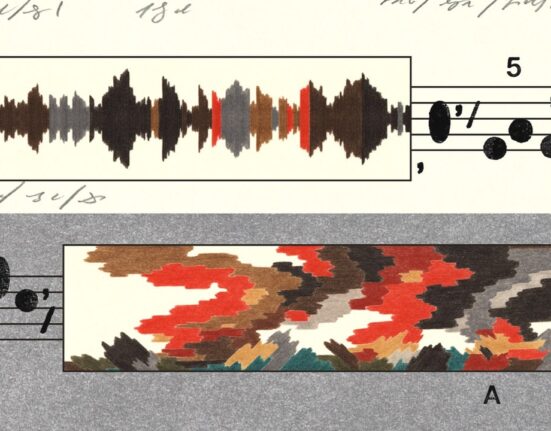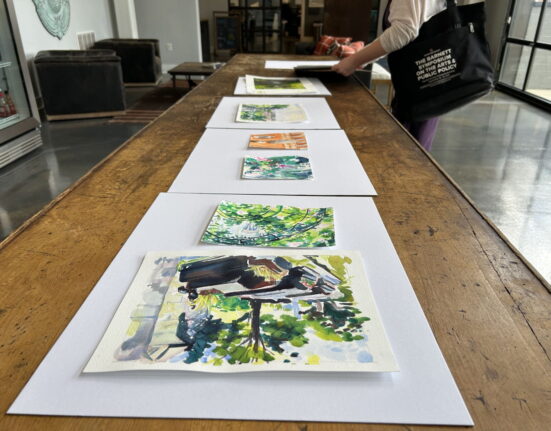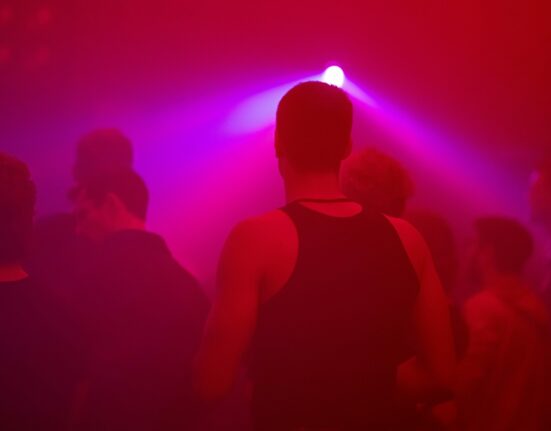On a recent Saturday evening, the grand old railway station in the western Ukrainian city of Lviv was a sea of khaki. Soldiers of all ages milled around the central hall, saying goodbye to parents, children, grandchildren, lovers. All the while, units back from the front streamed out into the rain. One young vet had his kitbag in one hand and a Sports Direct holdall in the other; a companion clutched a bulging North Face bag. They slumped into the café I was sitting at, just opposite the station, and ordered chicken schnitzel and cappuccinos.
There was a similar scene at Kyiv’s main station just before dawn the next morning when I alighted from the night train. Thousands of soldiers thronged the platforms.
As I drove through the deserted streets to my hotel, I thought of them fanning out south and east on their way to the front.
If you stay clear of railway terminals, however, you can spend days in the capital and have little sense that the country is at war. That morning I walked through the central Shevchenko Park. A dozen women in their sixties and seventies were doing callisthenics under the gaze of a stern, silver-haired man. Elegant young couples strolled past with toddlers in pushchairs. Maybe it was like this in London in the latter phase of the second world war, when the only risk was from a relatively rare rocket obliterating your home — as in Kyiv now.
I was bound for the Ministry of Desserts, a green and pink pastel café, which is a haunt of the beau monde. The talk at my table was the staple of Kyiv: the front, the mindset of Volodymyr Zelenskyy, the state of the backbone of the west. But the setting seemed very Knightsbridge or Kensington, as did the clientele, chatting over lattes and cakes. Normal life seems to have returned to the city. Except, of course, it hasn’t.
On my first full day in Kyiv, I went to the government headquarters. Sandbags blocked the windows. Camouflage netting covered the entrance. Lights were dimmed in the corridors. Denys Shmyhal, prime minister since 2020, was wearing the trademark uniform of the government-at-war: black T-shirt under a black shirt, with black jeans. He is one of a small band of technocrats frantically refashioning an economy that shrank 30 per cent last year and is neither fully primed for war nor for the reforms needed to join the EU.
No one will quite say it, but the fear in Kyiv is that their war will be “forgotten” and the west’s supply of funds and arms will slow. Then there is the concern that Donald Trump will win re-election in the US and promptly do a deal with Putin to end the war. Is the clock ticking, I asked? “This clock has been ticking for us since 2014,” said Shmyhal, referring to the year Putin annexed Crimea and irredentists seized a chunk of the eastern Donbas. (Visitors soon learn to refer to February 2022 not as “the invasion” but as the “full-scale invasion”.)
Kyiv has had to learn the art of diplomacy, to display deference to the White House and appreciation to allies for their support. But as for the fear that the west will be fickle, Ukrainians have no illusions: it has happened before. Western leaders negotiated a deal with Putin after 2015 and then turned their backs. So the game plan is to forge a war economy, focused on defence and technology — on the model of Israel. Shmyhal used his pen to sketch some of the thinking, including fortified substations to protect the grid.
He then laid out an uplifting vision for a dynamic modern state, fit for the EU. Ukraine can be an “energy hub” for Europe, storing “33bn cubic metres” of natural gas, he said. It will reduce its reliance on the vulnerable ports of the Black Sea by processing more of its harvest domestically, so it can export a smaller volume of grain. It will turbocharge its tech sector, as it has done to produce drones. As for the EU’s concerns over corruption in the opaque state sector, Shmyhal assured me they are being addressed. It was an inspiring prospectus, but he and his fellow data-driven ministers have so much to do.
An hour had passed and we still hadn’t discussed the fighting — a reflection of the many crises Ukraine faces away from the front but also the stagnant state of the war. Stalemate is still all but a banned word. “Basically our girls and boys are crawling on their stomachs to try to demine by hand these expansive minefields,” Shmyhal said of the counteroffensive launched this spring. “We shall just continue to grind through, gaining 100, 300, 800 metres a day.”
Kyiv’s prescription is simple. Ukraine needs more of the west’s promised long-range missiles to push back Russia’s behind-the-lines secondary defences and F16 jets to counter Russian dominance of the air. Then Ukrainians would be able to make advances if or when they break through. But, as Shmyhal concedes, Russia has also been preparing — with all the focus and force that an autocratic system can bring to bear.
It was sunset when the interview ended. Nikita, the Financial Times’s fixer, was waiting outside. We took the highway to Kharkiv, Ukraine’s second city, a six-hour drive east, joining a stream of civilian lorries and cars.
Kharkiv, an industrial powerhouse turned tech hub, is a classic of the art nouveau school of architecture. Even in their current bruised state, with windows boarded up and shell scars, the squares and villas of the city centre are stunning, particularly on a crisp autumn morning under a diamond-bright sky.
But in the suburbs a mile or so to the north-east, the full horror of last year’s assault is clear. When Russian troops crossed the border, a mere 20 miles away, they raced towards Ukraine’s second city, assuming its fall a formality. Held off on the city’s outskirts, they unleashed a ferocious barrage. Whole facades of 25-storey apartment blocks have collapsed, exposing interiors as if a giant’s doll’s house has been ripped open. It is remarkable, I told Natalka Marynchak, that she stayed in the city when most, understandably, had fled. “I had three reasons,” she said, smiling. “My father is a priest and I wanted to drive him to his church; I have cats and dogs; and I just felt I should stay on this land. The land holds you, you cannot leave it.”
Marynchak is a poet who became something of a celebrity last year, posting daily on Facebook about life under siege. We are meeting at Pakufuda, a “coffee and board games” café in the city centre. It is abuzz with young things hunched over their laptops. After all, there hasn’t been a missile strike in the city for four days. “We try to live life to the [fullest],” said Marynchak. “I didn’t go to the gym, but now I do. I never collaborated with other artists before, but now I do, with a jazz player and a painter. We fill our lives, that’s why we feel calmer than the Ukrainians who left.”
Like many Ukrainians, Marynchak is grappling with a conundrum: how to tackle the growing divergence between those who left and those who stayed. Before the war, the city’s population was 1.5 million. It’s now about 1.1 million including 500,000 people from areas near the front or occupied by the Russians. Many Kharkivans are among the estimated five or six million Ukrainians currently exiled throughout Europe.

When I raised this with Ihor Terekhov, the craggy mayor of Kharkiv, and separately with Oleksandr Kubrakov, the minister of infrastructure, another of President Zelenskyy’s young data stars, both expressed concern that Ukraine will lose a chunk of its population for good. They worry that the relative affluence of life in the west and uncertainties back home will stop citizens from coming back.
Marynchak is more worried about the psychological rift. “Sometimes the fear of losing the people who left is bigger than the fear of being in the centre of things,” she said. “I understand it’s up to me whether this gap becomes bigger or whether we can build bridges. I do want to. We have to be united because the enemy’s goal is to divide us.” Still, it can be hard to talk with those who left, she said. “They don’t understand what we feel, and we don’t understand what they feel. They think that everything is ruined here. We think rebuilding will be easier than they do.”
Ten miles closer to the Russian border, in the village of Staryi Saltiv, the handful of residents who have returned are delighted to see their old homes, whatever their state. Alexandra, a 62-year-old retired teacher, was gazing up at a couple of city employees tossing out rubble from the remains of her fourth-floor flat. She had lived there for 40 years, after being sent from her native Russia during the Soviet era to teach in Kharkiv. She fled in February last year, shortly before her block was hit. Now she’s living in a “tiny dacha” a few miles away.
Alexandra had just rummaged through the debris of her old life to rescue a couple of plastic bags of possessions, including a pair of dust-covered rubber shoes and a ceremonial sword. “Everything will be good. We are rebuilding, and the state will help,” she said, referring to a scheme to give individuals the equivalent of $5,000 to fund home repairs. As for the threat of missile attacks, her lip curls. “This is our land. Go fuck yourself, Russians! We will stay here.”
She embodies the defiant spirit of Ukraine, but all the while society is under increasing strain. It has been 21 months since men of fighting age were barred from leaving the country. “A lot of families are broken,” an NGO worker in Kharkiv told me. He cited the experience of a neighbour whose marriage had disintegrated because of the war. “His wife and children are in London and they now have a much higher standard of life. She doesn’t want to return. Soon two years will have passed and they have grown apart. It’s impossible to speak of bringing people back until the war is over and who knows when that will be.” He pauses. “We are human. Maybe seven million people will start a new life and not come back to Ukraine.”
Back in Kyiv, on my last morning in Ukraine, I see someone who knows more about the mental stresses of the war than just about anyone. Kseniia Voznitsyna is head of the Veterans’ Mental Health and Rehabilitation Centre. The 48-year-old neurologist has been treating soldiers since 2014. She and her team currently treat 220 a day for post-traumatic stress syndrome and concussions.
“Every soldier has concussion [symptoms], some two, three or five episodes because Russians use an enormous amount of artillery,” she told me. “The explosion waves are very traumatic. It’s an invisible wound. All my guys look fine, but it has behavioural and emotional symptoms, and is often accompanied by depression.” She called it a “clinical chameleon”, because it can remain hidden. “After two to five years, people will face post-concussion syndrome — aggressive behaviour, suicidal tendencies. People don’t pay enough attention to it.”
Before her centre opened five years ago, Voznitsyna was practising in a smaller clinic. Until last February, the centre treated veterans and trained their families and social workers; now it focuses on the troops. After a few weeks of treatment, many return to fighting, she said. “Half we can help. The others are not ready . . . ”
An even greater concern for her is the long-term effect of war on the whole of Ukraine. “I always say the mental health of veterans depends on everyone. It’s not the veteran who should integrate, it’s society who should integrate with him. You can’t be too soft. Don’t over-heroise them. They often feel they didn’t do enough. Or they can be worried that they are alive and their brothers are dead.”
I recalled a conversation I had had the previous day with Andrey Stavnitser, one of Ukraine’s most prominent businesspeople, who has set up Superhumans, a rehab centre for people who have lost limbs. He believes a fundamental rift is growing between those who fought and those who didn’t. “There is a massive sense of guilt felt by those who did not go to war,” he said. “It is the biggest pain point in society, and we will have it for years.” He also worries that returning soldiers will become disillusioned with politics — as happened when Soviet Army veterans returned from Afghanistan.
Voznitsyna broadly agreed. “You do not see the war,” she said. “It’s a big problem. I don’t know what to answer.”
She breaks off as “Happy Birthday” rings out happily from a table at the other side of the café where we are sitting. “There are men who say we fight so you can have a normal life. But a lot of soldiers realise that a lot of people don’t donate, don’t volunteer and are not connected to the war.” After the war, it will be so important how we commemorate those who died, she said. “Every ministry has to have a veterans’ policy. I just hope that works.”
A few hours later, I sat with Oleksandr Mykhed, one of Ukraine’s foremost writers and the author of two haunting recent essays for FT Weekend. On our mind is Ukraine’s formidable achievement in having stoically borne the horrors of this war, its determination to stay the course and the new Ukrainian identity being forged — but also the reality of the coming months and years. Around us, dozens of people were having lunch and drinking beer in the sun. “This is all an illusion,” Mykhed said, waving his hands at the happy scene. “Everyone here has lost somebody in this war.”
Alec Russell is the FT’s foreign editor






